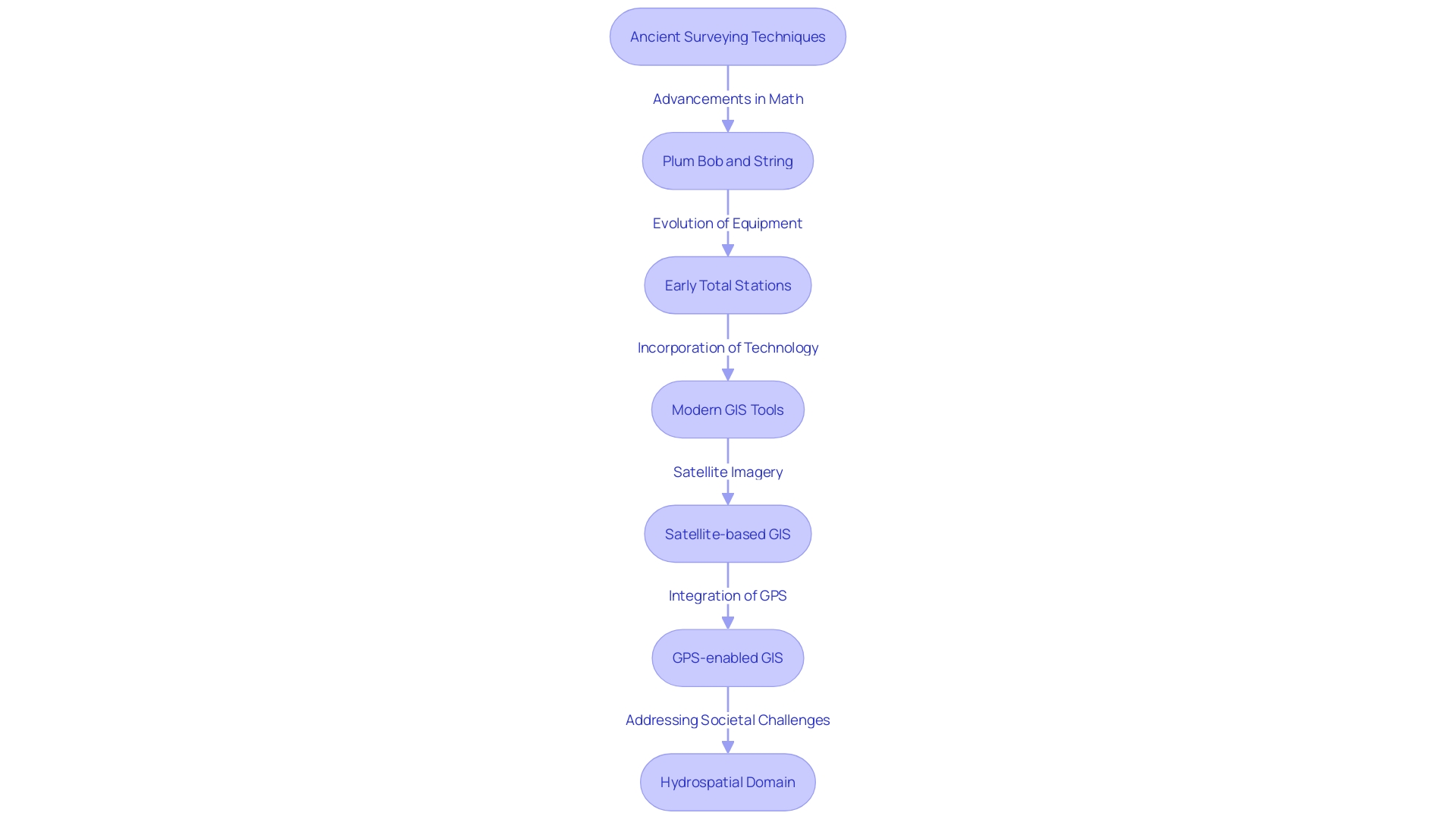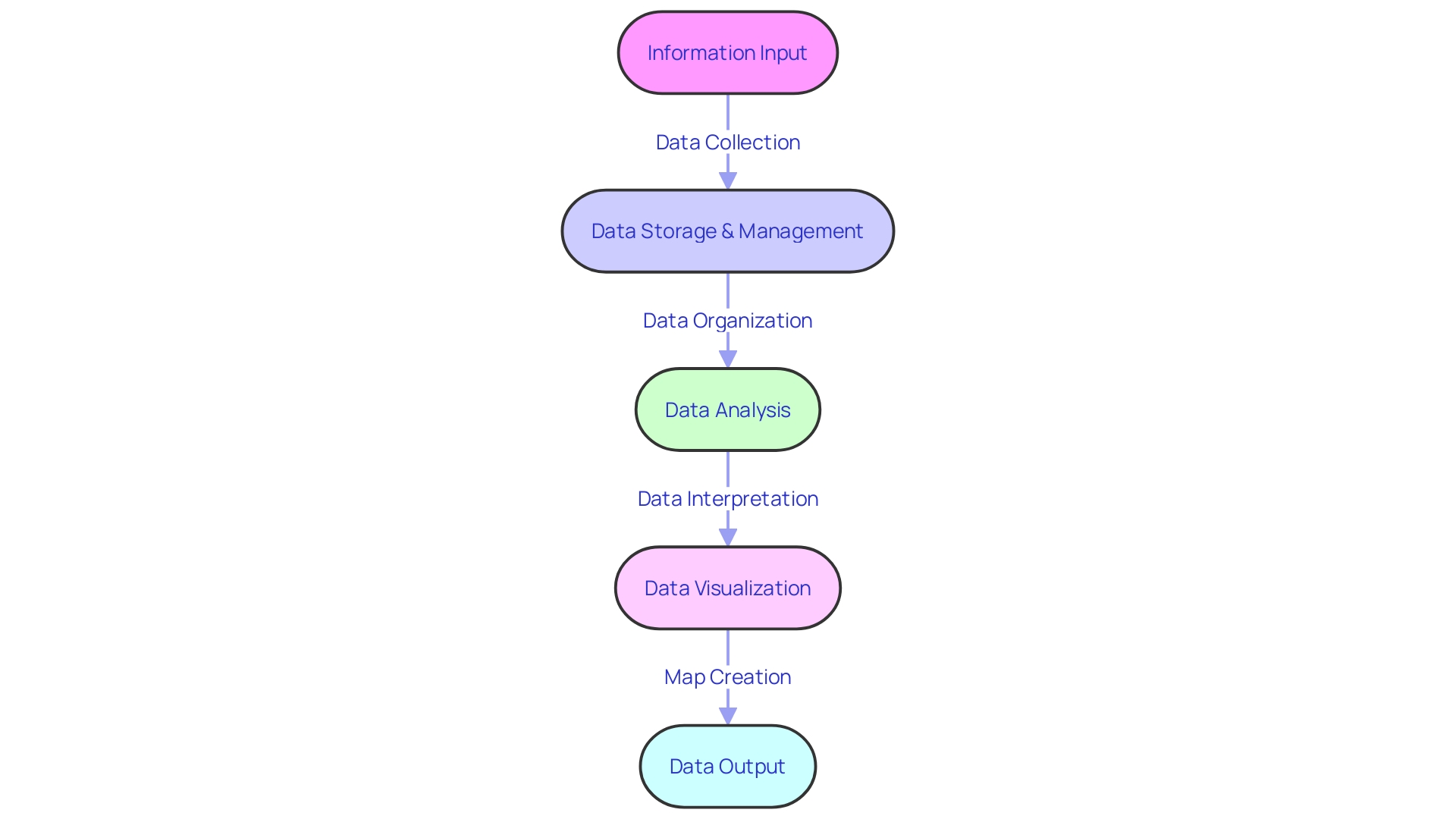Introduction
Tracing its origins back to ancient civilizations, Geographic Information Systems (GIS) land mapping has evolved into a sophisticated discipline that harnesses the power of computer technology to store, analyze, and overlay vast arrays of geographic data. This article explores the history, key components, applications, benefits, challenges, and future trends of GIS land mapping. From facilitating urban planning and infrastructure development to advancing environmental conservation and public health, GIS has become an indispensable tool that supports informed decision-making and propels us towards a sustainable future.
Join us as we delve into the world of GIS and uncover its transformative potential in shaping our environment.
What is GIS Land Mapping?
Tracing its humble beginnings to simple tools like string and rocks, surveying has been integral to human development since ancient times. The mathematical precision required for constructing the great edifices of Egypt and Greece laid the groundwork for what would become Geographic Information Systems (GIS). In the modern era, GIS land mapping has evolved into a sophisticated discipline, harnessing the power of computer technology to store, analyze, and overlay vast arrays of geographic information. Today, GIS is not just about creating maps; it's a versatile tool that supports a wide range of applications, from facilitating urban planning and infrastructure development to advancing conservation and public health.
GIS has transformed into a cornerstone of modern living, as evidenced by the ease with which we access spatial data through our smartphones to check the weather or navigate to our next appointment. The integration of layers—from roads and landmarks to weather conditions—provided by GIS allows for an unprecedented level of analysis and interpretation. This technology plays a crucial role beyond our personal devices; it's pivotal in industries ensuring efficient logistics, in scientific research tracking the spread of diseases, and in ecological studies monitoring wildlife movements and climate change impacts.
Significant applications of GIS involve initiatives by the Pacific Community (SPC) to educate individuals on utilizing technology for terrestrial and marine mapping, addressing ecological and development needs. In Majuro, trainees learned to map geographic points in real-time, a testament to GIS' practicality in fieldwork. Similarly, the City of Plano, Texas, demonstrates GIS' value in urban management by employing Esri’s ArcGIS to oversee its extensive water system, ensuring compliance with rigorous regulations.
As we confront the Triple Planetary Crisis—climate change, biodiversity loss, and pollution—GIS combined with Artificial Intelligence (AI) presents a beacon of hope. Initiatives like the Landscape Assessment report by Columbia University and partners are pursuing high-impact AI applications to drive innovation in scalable climate and nature solutions, highlighting the transformative potential of integrating AI with GIS.
In sum, GIS land mapping has become an indispensable tool that not only supports informed decision-making but also propels us toward a sustainable future, underpinning efforts to mitigate challenges and foster a more equitable society.
History of GIS and Its Evolution
Tracing the origins of Geographic Information Systems (GIS), we delve into the history of surveying, where ancient civilizations like Egypt and Greece laid the groundwork using rudimentary tools such as strings and rocks. These basic methods established a foundation for the application of mathematical principles to erect some of the most iconic structures known to history. Fast forward to the 20th century, the inception of GIS emerged in the 1960s, marking a pivotal shift in spatial analysis powered by the burgeoning field of computer technology.
Significant advancements in hardware, software, and information spread have subsequently revolutionized GIS from basic map digitization to a powerful analytical framework, incorporating satellite imagery and GPS information into its core. This evolution is poignantly illustrated in the SYMAP project of 1963, which introduced spatial-analytic features for the first time. Such advancements mirror the progression of surveying techniques, from the creation of a plumb bob for vertical alignment to the development of sophisticated total stations that exponentially increased accuracy.
In contemporary times, GIS and mapping solutions have transcended their initial roles, becoming integral to addressing societal challenges. A prime example of this is Minnesota's strategic use of mapping to address concerns like child poverty and health, highlighting the potential of GIS to shape policy and enhance lives. Furthermore, contemporary GIS tools provide insights into different facets, such as air quality and green spaces, empowering communities and professionals alike with actionable environmental information.
The cumulative advancements in GIS reflect a journey from foundational mathematical applications to the complex, multifaceted Hydrospatial domain we witness today. Denis Hains, with over four decades in geodesy, encapsulates this journey, highlighting the transformative impact of technology on the hydrography profession and the broader realm of spatial information. As we navigate through a world increasingly reliant on spatial information, GIS stands as a testament to human ingenuity, providing a lens through which we can better understand and shape our environment.

Key Components of GIS Land Mapping
Geographic Information Systems (GIS) play a crucial role in the visualization and analysis of spatial information, which are vital in a wide range of sectors from urban planning to environmental conservation. At its core are several integral components that work in tandem:
-
Information Input: The lifeblood of GIS is the information sourced from a variety of methods, including satellite imagery, aerial photography, GPS surveys, and pre-existing cartographic products. This data is meticulously gathered and transformed into a digital format that is compatible with advanced GIS platforms.
-
Data Storage and Management: At the heart of GIS technology is its robust database systems, which meticulously store and categorize vast spatial datasets. These datasets are organized into thematic layers that might include, but are not limited to, property boundaries, infrastructural networks, and various ecological features.
-
Data Analysis: GIS is not just a storage system; it's also an analytical powerhouse. With sophisticated toolsets, it enables intricate processes such as spatial clustering, overlay analysis, and proximity calculations, as well as complex modeling. These analytical capabilities are crucial for understanding and addressing the Triple Planetary Crisis of climate change, biodiversity loss, and pollution that we currently face.
-
Data Visualization: Perhaps one of the most striking aspects of GIS is its capability to produce visually compelling and informative graphics. Modern GIS software offers an array of visualization options like thematic mapping, 3D modeling, and interactive map displays, which not only present data but tell a story that aids in decision-making processes.
-
Data Output: Finally, the culmination of GIS processes allows for the generation of customized reports, maps, and charts, which provide valuable insights and can be disseminated in various formats suitable for print, digital, or web platforms. Through the burgeoning integration of artificial intelligence, GIS is also playing a transformative role in industries such as telecommunications, where it aids in network planning and asset management, as well as in climate and nature solutions where it supports the tracking and analysis of environmental changes.
In essence, GIS offers a technological gateway to a deeper understanding of our world, enabling us to map and analyze the fabric of our environment with unprecedented precision and insight. It stands at the crossroads of history and innovation, drawing from millennia of surveying practices and mathematical principles to address contemporary challenges and shape a sustainable future.

Applications of GIS Land Mapping
Geographic Information Systems (GIS) have evolved significantly from their early beginnings, where basic tools like string and rock were used in surveying to establish vertical surface lines and conduct mathematical calculations. Today's GIS mapping extends its utility across numerous sectors with precision and sophistication.
- Land Use Planning: GIS has become integral in assessing areas for various uses, providing zoning analysis, and pinpointing potential development locations. Urban planners and policymakers rely on GIS for data-driven decisions regarding the utilization of space and infrastructure development, ensuring efficient urbanization and resource allocation.
In the realm of ecological stewardship, GIS operates as a vital tool for natural resource monitoring, land cover change tracking, habitat suitability analysis, and conservation planning. It plays a vital role in conducting impact assessments and promoting sustainable development, aligning with the global movement for climate action, as seen in Kenya's restoration initiatives.
-
Transportation and Infrastructure: For the creation and upkeep of transportation networks, including roads, railways, and pipelines, GIS offers solutions in route optimization, traffic pattern analysis, and identification of congestion or accident-prone zones. For example, the City of Plano, Texas, utilizes GIS alongside other digital tools to manage its extensive water system and comply with regulatory requirements efficiently.
-
Emergency Management: In disaster management and emergency response, GIS aids by mapping evacuation routes, identifying vulnerable areas, and facilitating rescue operations. This capability is essential in addressing the Triple Planetary Crisis of climate change, biodiversity loss, and pollution.
-
Utilities and Facilities Management: Utility companies employ GIS for infrastructure network management related to water supply, electricity distribution, and telecommunications. It supports asset tracking, maintenance scheduling, and service delivery optimization, as evidenced by the telecom industry's increasing reliance on GIS for network installation and maintenance.
Geospatial information's significance goes beyond these applications, infiltrating everyday life in the form of smartphone apps, weather forecasts, and navigation services. As the geospatial industry gears up for a new era of connectivity, the integration of GIS and Artificial Intelligence (AI) is pinpointed as a transformative force to address environmental threats and foster a sustainable society, as highlighted in the collaborative Landscape Assessment report by Columbia University, the University at Albany, SUNY, and Esri.
Benefits of Using GIS in Land Mapping
Geographic Information Systems (GIS) have transformed the way we comprehend and make use of spatial information. With GIS, stakeholders have access to comprehensive and accurate spatial information, which is critical for informed decision-making. This technology allows for the evaluation of various scenarios, risk assessment, and identification of the most appropriate property choices.
The effectiveness of GIS is especially clear in its automation of tasks, reducing the time and effort traditionally needed for information collection, analysis, and visualization. This automation streamlines processes, bolsters productivity, and contributes to cost savings as well as faster completion of projects.
GIS is also pivotal in optimizing resource allocation. It plays a key role in maximizing the use of land, infrastructure, and natural resources, pinpointing underutilized areas to minimize waste. By enabling more strategic use of resources, GIS fosters enhanced productivity and sustainability.
Communication and collaboration are further improved through GIS as it provides a unified platform for all stakeholders to share spatial data, analysis results, and project updates. This common platform enhances transparency and promotes more effective decision-making.
Moreover, GIS supports sustainability by offering tools for analysis, conservation planning, and ecological monitoring. It aids in reducing the impact of human activities on ecosystems, thereby promoting a balance between development and environmental stewardship.
Real-world applications of GIS are evident in various case studies. For instance, the City of Plano, Texas, leveraged Esri’s ArcGIS to create an inventory for its extensive water system, demonstrating GIS' role in making data-driven decisions. Furthermore, in Mayo-Kebbi Est, a participatory mapping project significantly empowered women, enabling them to take part in land management decisions, showcasing GIS's transformative social impact.
The everyday conveniences we enjoy - from checking the weather to finding the fastest route to our next appointment - all depend on the spatial data organized and made accessible through GIS. These systems have become integral to numerous industries, assisting with logistics, aiding scientific research, and supporting social sciences. GIS is instrumental in applications ranging from tracking disease spread and wildlife movement to urban planning and scrutinizing the effects of spatial apartheid, as seen in South Africa.
Historically, the evolution of surveying, from the simplest tools to sophisticated total stations, has been closely tied to advancements in mathematics and technology. Today, GIS sustains this heritage, harnessing the potential of artificial intelligence to tackle global challenges, such as climate change and threats to the environment. The collaborative efforts between institutions like Columbia University and Esri exemplify the commitment to harnessing AI in concert with GIS for scalable and impactful solutions to the most pressing environmental issues of our time.

Challenges and Considerations in GIS Land Mapping
Geographic Information Systems (GIS) and land mapping technologies are crucial for sustainable land administration and socio-economic planning. However, leveraging these advanced tools comes with certain challenges:
-
The foundation of GIS analysis is the quality and accuracy of the input information. Reliable information is crucial, yet obtaining it can be arduous. Inaccuracies in information collection or processing can skew analysis and lead to unreliable outcomes. For example, the First Nations in Canada have demonstrated the significance of empowering local communities to effectively manage their information, thereby improving information reliability and utilization.
-
Data Integration and Compatibility: The integration of disparate datasets is a complex task in GIS. Ensuring that various formats, coordinate systems, and projections work together harmoniously is essential for precise analysis. In Plano, Texas, the integration of Esri's ArcGIS with other digital tools exemplifies the complexities and potential of information integration for managing extensive water systems.
-
Ensuring confidentiality and protection of sensitive information like ownership requires strict measures for privacy and security. As property records become digitized, as seen in Bangalore, India, safeguarding this information from misuse becomes paramount to avoid exacerbating the 'data divide' and safeguarding against inequality.
-
Technical Expertise: The effective deployment of GIS technologies necessitates specialized knowledge. Training existing staff or hiring skilled GIS professionals is a strategic investment for organizations to fully harness the benefits of GIS capabilities.
-
Cost and Infrastructure: The cost of implementing and maintaining a GIS infrastructure can be a hurdle, especially for smaller entities. Investments must cover hardware, software licenses, data procurement, and ongoing system maintenance.
By confronting these challenges head-on, organizations can optimize their GIS and mapping solutions to support informed decision-making and contribute to a future of improved land management and service delivery.
Future of GIS Land Mapping: Emerging Trends and Technologies
Technological advancements are set to expand the horizons of GIS land mapping, with several key trends emerging that promise to revolutionize the field. Cloud-based GIS solutions are becoming more and more popular, offering scalable and accessible platforms that enable remote access to information and collaborative opportunities without the need for extensive hardware investments. Mobile GIS has become a game-changer in field collection, leveraging the GPS capabilities of mobile devices to provide real-time mapping and sharing on the move, which enhances both efficiency and accuracy of fieldwork.
Furthermore, the collaboration of GIS with extensive information analytics and artificial intelligence (AI) is revealing new possibilities in spatial analysis. Ai's intelligent behavior in processing large datasets and automating feature extraction, as highlighted by industry leaders like Esri and academic institutions such as Columbia University, is paving the way for advanced predictive modeling and more informed decision-making processes. The integration of GIS with the Internet of Things (IoT) further expands its capabilities, allowing the real-time monitoring and analysis of various ecological and infrastructural parameters through sensor information.
Additionally, the immersive experiences offered by virtual and augmented reality (VR/AR) technologies are enhancing the way users interact with and understand spatial data. As we navigate through a world facing the triple planetary crisis of climate change, biodiversity loss, and environmental pollution, the innovative use of GIS and related technologies in landscape assessments and climate action plans is becoming increasingly critical.
The geospatial industry is also experiencing rapid transformation due to digitization, especially in sectors such as telecommunications, where GIS tools are instrumental in network planning and asset management. This is particularly evident in the telecom industry's adoption of spatial technology to improve operational effectiveness and cater to growing demands.
From the ancient practices of surveying with basic tools and mathematics to today's sophisticated GIS applications, the evolution of land mapping reflects a long history of innovation. Field surveying, one of the oldest organized trades, continues to play a vital role in various industries, now enhanced by modern technology to increase precision and eliminate errors. As we stand at the threshold of a new industrial epoch, the 'where' has never been more critical, and GIS mapping solutions are at the forefront of this new era of connectivity and convergence.
Conclusion
In conclusion, GIS land mapping has evolved into a sophisticated discipline that harnesses computer technology to store, analyze, and overlay geographic data. It supports various applications, from urban planning to environmental conservation, and is an indispensable tool for informed decision-making.
GIS has a rich history rooted in ancient surveying practices and has transformed through advancements in hardware, software, and data proliferation. Today, it plays a crucial role in sectors such as land use planning, environmental management, transportation and infrastructure, emergency management, and utilities and facilities management.
The key components of GIS land mapping include data input, storage and management, analysis, visualization, and output. These components work together to provide comprehensive spatial information, automate tasks, optimize resource allocation, improve communication and collaboration, and support environmental sustainability.
The benefits of using GIS in land mapping are significant. It provides access to accurate spatial information, streamlines processes, optimizes resource allocation, enhances communication and collaboration, and supports environmental sustainability.
However, leveraging GIS and land mapping technologies also comes with challenges such as data quality and accuracy, data integration and compatibility, data privacy and security, technical expertise, and cost and infrastructure.
Looking towards the future, emerging trends such as cloud-based solutions, mobile GIS, the synergy of GIS with big data analytics and artificial intelligence (AI), and the integration of GIS with the Internet of Things (IoT) promise to revolutionize GIS land mapping.
In summary, GIS land mapping is a versatile tool that supports informed decision-making and propels us towards a sustainable future. It has a rich history and has become crucial in various sectors. By addressing challenges and embracing emerging trends and technologies, we can harness the transformative potential of GIS to shape our environment and address global challenges.
Experience the significant benefits of GIS in land mapping today!




